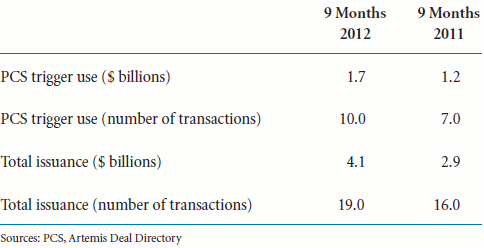Property Claims Services (PCS), a leading source of data on insured property losses from catastrophes in the U.S. and part of the Verisk group of companies, have today published their latest quarterly update on the catastrophe bond market. The report takes a look at the market from PCS’ perspective and contains insight into the use of their PCS Catastrophe Loss Index tool which is the dominant source of U.S. insurance industry loss data for use in cat bond triggers.
The third quarter of the year is notoriously quiet in the catastrophe bond market due to the U.S. hurricane season beginning and the threat that poses to the cat bond market. 70%+ of the world’s outstanding cat bonds hold some exposure to U.S. wind, and so it’s unsurprising that issuance slows and not much comes to market. Hence the PCS Catastrophe Loss Index was involved in just one transaction during the quarter.
However, the numbers for the first nine months of the year are impressive and show that usage of the PCS Catastrophe Loss Index as a trigger within cat bond deals is up 43% on the first nine months of 2011. PCS’ report notes the lack of European peril exposed transactions in the third-quarter of 2012, something difficult to account for given the strong demand. However we have had a number of years of strong issuance of European perils, so it is possible that the market just doesn’t need to transfer more of that risk at this time. There are also a number of European deals up for renewal over the next 6 to 12 months, so people we talk with in the market believe, as does PCS, that this is likely a lull. Despite this lull issuance is up for the first nine months of the year and the volume of capital issued in the cat bond market is up too, both very positive factors.
Issuance for the first nine months of 2012 is up significantly on the same period in 2011, with nineteen cat bond deals this year compared to 16 in 2011, totalling over $4 billion this year compared to under $3 billion in 2011. Only one third-quarter cat bond featured a PCS index trigger, Queen Street VI Re Ltd. used the PCS Catastrophe Loss Index for the industry loss trigger for the U.S. hurricane component of the bond (which also covered European windstorm).
So far in 2012, issuers have used the PCS catastrophe index for triggers in 10 cat bond transactions, which is up 43% from the 7 it was used in during the same period of 2011. Risk capital transferred in cat bond transactions which used a PCS trigger is up 42% from the $1.2 billion of cat bond capacity in 2011 to $1.7 billion of cat bond capacity issued in 2012. 53% of all transactions have used a PCS trigger so far this year and 67% of U.S. peril exposed cat bonds, by number of deals.

PCS Catastrophe Loss Index trigger use in catastrophe bond transactions
PCS notes that in the third-quarter of 2012, cat bond issuers used the PCS Catastrophe Loss Index in 25% of transactions exposed to U.S. perils. Over 2012 as a whole, if you discount indemnity triggered bonds, the PCS Catastrophe Loss Index was used in 81% of cat bond transactions where an industry-loss trigger was an appropriate alternative, according to PCS.
PCS commented that we could be in for a record year of cat bond issuance if the market comes back in the fourth quarter with the appetite it had earlier in the year. So far all signs point to this happening, but PCS note that all bets would be off if we had a major hurricane landfall before the end of the season or some other major global catastrophe event. Any catastrophe event would change the dynamic of the market and investors motives and appetite could be impacted, this could of course lead to increased issuance rather than reduced.
We spoke with Gary Kerney, Assistant Vice President, Property Claims Services, to ask what developments he had noticed in the cat bond market in recent months, he responded; “In today’s catastrophe bond market, we’re seeing something interesting: opportunities for both standardized transactions and customized transactions. Innovation is moving forward in a way that addresses the potential interests of investors – standardized transactions, for example, make them easier to review and understand. And at the same time, we’re seeing advancements in structure that allow carriers to transfer risk in a targeted manner. Both ends of the spectrum are being addressed.”
The report from PCS closes with a great paragraph which we quote below in full:
In the end, risk bearers vote with their capital, and so far, their support of the catastrophe bond market has been significant — and growing. The market has seen the convergence of traditional reinsurance and insurance-linked securities. Rather than make that distinction in the future, carriers are likely to perceive capital as capital, evaluating the different forms to construct targeted and effective strategies for capital optimization.
You can access the full report from PCS via their website.
We covered PCS’ last update in an article back in July, so if you want to look back and compare numbers you can do so here.
We also recently interviewed Gary Kerney from PCS, the interview is available here.
 View all of our Artemis Live video interviews and subscribe to our podcast.
View all of our Artemis Live video interviews and subscribe to our podcast.
All of our Artemis Live insurance-linked securities (ILS), catastrophe bonds and reinsurance video content and video interviews can be accessed online.
Our Artemis Live podcast can be subscribed to using the typical podcast services providers, including Apple, Google, Spotify and more.































